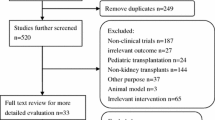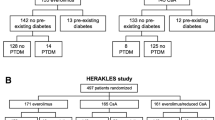Abstract
Backgrounds/Aims
Elevated uric acid (UA) levels are frequently observed after renal transplantation. We investigated the consequences of shifting from calcineurin inhibitors (CNI) to mammalian target of rapamycin inhibitors (mTORi) on UA levels and graft functions.
Methods
Ninety-six patients were enrolled. Main points of interest were changes in UA and glomerular filtration rate (GFR).
Results
Mean age of the whole population was 39 ± 11 years (18–73), and 64.2 % were male. Patients were stratified into two groups according to their CNI type prior to the switch as cyclosporin A (CsA) or tacrolimus (Tac). Patients that were switched from CsA had a mean GFR of 49 ± 18 ml/min and serum UA level of 7.4 ± 1.8 mg/dl at the pre-switch period. Mean GFR increased to 53 ± 22 ml/min (p = 0.03), and UA levels decreased to 6.2 ± 1.6 mg/dl at the final visit (p < 0.001). In the Tac group, pre-switch mean GFR was 59 ± 28 ml/min and serum UA level 6.6 ± 2.6 mg/dl. In this group, mean GFR increased to 63 ± 28 ml/min (p = 0.03) and UA levels decreased to 6.2 ± 2.1 at the last visit (p < 0.001).
Conclusion
Switch from CNI to mTORi-based regimen provides better control of UA levels and improves renal functions.




Similar content being viewed by others
References
Mulay AV, Cockfield S, Stryker R, Fergusson D, Knoll GA (2006) Conversion from calcineurin inhibitors to sirolimus for chronic renal allograft dysfunction: a systematic review of the evidence. Transplantation 82:1153–1162
Zoppini G, Targher G, Chonchol M et al (2012) Serum uric acid levels and incident chronic kidney disease in patients with type 2 diabetes and preserved kidney function. Diabetes Care 35:99–104
Kawano Y (2011) Uric Acid and blood pressure. Circ J 75:2755–2756
Kaya EB, Yorgun H, Canpolat U et al (2010) Serum uric acid levels predict the severity and morphology of coronary atherosclerosis detected by multidetector computed tomography. Atherosclerosis 213:178–183
Li Q, Yang Z, Lu B et al (2011) Serum uric acid level and its association with metabolic syndrome and carotid atherosclerosis in patients with type 2 diabetes. Cardiovasc Diabetol 10:72
Latif W, Karaboyas A, Tong L et al (2011) Uric acid levels and all-cause and cardiovascular mortality in the hemodialysis population. Clin J Am Soc Nephrol 6:2470–2477
Ford ES (2011) Uric acid and mortality from all-causes and cardiovascular disease among adults with and without diagnosed diabetes: findings from the National Health and Nutrition Examination Survey III Linked Mortality Study. Diabetes Res Clin Pract 93:84–86
Haririan A, Nogueira JM, Zandi-Nejad K et al (2010) The independent association between serum uric acid and graft outcomes after kidney transplantation. Transplantation 89:573–579
Kalantar E, Khalili N, Hossieni MS, Rostami Z, Einollahi B (2011) Hyperuricemia after renal transplantation. Transpl Proc 43:584–585
Kim KM, Kim SS, Han DJ, Yang WS, Park JS, Park SK (2010) Hyperuricemia in kidney transplant recipients with intact graft function. Transpl Proc 42:3562–3567
Saglam F, Celik A, Sarioglu S et al (2008) Hyperuricemia influences chronic cyclosporine nephropathy. Transpl Proc 40:167–170
Haririan A, Metireddy M, Cangro C et al (2011) Association of serum uric acid with graft survival after kidney transplantation: a time-varying analysis. Am J Transpl 11:1943–1950
Karbowska A, Boratynska M, Kusztal M, Klinger M (2009) Hyperuricemia is a mediator of endothelial dysfunction and inflammation in renal allograft recipients. Transpl Proc 41:3052–3055
Akalin E, Ganeshan SV, Winston J, Muntner P (2008) Hyperuricemia is associated with the development of the composite outcomes of new cardiovascular events and chronic allograft nephropathy. Transplantation 86:652–658
Sert M, Celik A, Kural K et al (2011) Results of 4-year analysis of conversion from calcineurin inhibitors to mTOR inhibitors in renal transplant patients: single-center experience. Ren Fail 33:789–794
Sayin B, Karakayali H, Colak T et al (2009) Conversion to sirolimus for chronic allograft nephropathy and calcineurin inhibitor toxicity and the adverse effects of sirolimus after conversion. Transpl Proc 41:2789–2793
Pöge U, Gerhardt T, Stoffel-Wagner B, Sauerbruch T, Woitas RP (2011) Validation of the CKD-EPI formula in patients after renal transplantation. Nephrol Dial Transpl 26:4104–4108
Sonoda H, Takase H, Dohi Y, Kimura G (2011) Uric acid levels predict future development of chronic kidney disease. Am J Nephrol 33:352–357
Kim KM, Kim SS, Yun S et al (2011) Uric acid contributes to glomerular filtration rate deterioration in renal transplantation. Nephron Clin Pract 118:136–142
Gagliardi AC, Miname MH, Santos RD (2009) Uric acid: a marker of increased cardiovascular risk. Atherosclerosis 202:11–17
Goicoechea M, de Vinuesa SG, Verdalles U et al (2010) Effect of allopurinol in chronic kidney disease progression and cardiovascular risk. Clin J Am Soc Nephrol 5:1388–1393
Yildiz A, Yilmaz R, Demirbag R, Gur M, Bas MM, Erel O (2007) Association of serum uric acid level and coronary blood flow. Coron Artery Dis 18:607–613
Corry DB, Eslami P, Yamamoto K, Nyby MD, Makino H, Tuck ML (2008) Uric acid stimulates vascular smooth muscle cell proliferation and oxidative stress via the vascular renin-angiotensin system. J Hypertens 26:269–275
Lyngdoh T, Marques-Vidal P, Paccaud F et al (2011) Elevated serum uric acid is associated with high circulating inflammatory cytokines in the population-based Colaus study. PLoS ONE 6:19901
Feig DI (2011) Uric acid and hypertension. Semin Nephrol 31:441–446
Rodrigues TC, Maahs DM, Johnson RJ et al (2010) Serum uric acid predicts progression of subclinical coronary atherosclerosis in individuals without renal disease. Diabetes Care 33:2471–2473
Bae MH, Lee JH, Lee SH et al (2011) Serum uric acid as an independent and incremental prognostic marker in addition to N-terminal pro-B-type natriuretic peptide in patients with acute myocardial infarction. Circ J 75:1440–1447
Jalal DI, Rivard CJ, Johnson RJ et al (2010) Serum uric acid levels predict the development of albuminuria over 6 years in patients with type 1 diabetes: findings from the Coronary Artery Calcification in Type 1 Diabetes study. Nephrol Dial Transpl 25:1865–1869
Mazali FC, Mazzali M (2011) Uric acid and transplantation. Semin Nephrol 31:466–471
Mazzali M, Kim YG, Suga S et al (2001) Hyperuricemia exacerbates chronic cyclosporine nephropathy. Transplantation 2001(71):900–905
Perico N, Codreanu I, Caruso M, Remuzzi G (2005) Hyperuricemia in kidney transplantation. Contrib Nephrol 147:124–131
Kanbay M, Akcay A, Huddam B et al (2005) Influence of cyclosporine and tacrolimus on serum uric acid levels in stable kidney transplant recipients. Transpl Proc 37:3119–3120
Maharaj S, Assounga AG (2010) Conversion of cyclosporine to sirolimus before 12 months is associated with marked improvement in renal function and low proteinuria in a South African renal transplant population. Exp Clin Transpl 8:14–18
Bumbea V, Kamar N, Ribes D et al (2005) Long-term results in renal transplant patients with allograft dysfunction after switching from calcineurin inhibitors to sirolimus. Nephrol Dial Transpl 20:2517–2523
Claes K, Meier-Kriesche HU, Schold JD, Vanrenterghem Y, Halloran PF, Ekberg H (2011). Effect of different immunosuppressive regimens on the evolution of distinct metabolic parameters: evidence from the Symphony study. Nephrol Dial Transpl. 26 May 2011
Morales JM, Andrés A, Dominguez-Gil B et al (2003) Tubular function in patients with hypokalemia induced by sirolimus after renal transplantation. Transpl Proc 2003(35):154–156
Stallone G, Infante B, Pontrelli P et al (2011) Sirolimus and proteinuria in renal transplant patients: evidence for a dose-dependent effect on slit diaphragm-associated proteins. Transplantation 91:997–1004
Acknowledgments
The authors would like to thank Prof. Evert J. Dorhout Mees and for his critical review of the manuscript.
Conflict of interest
The authors declare no conflict of interest.
Author information
Authors and Affiliations
Corresponding author
Rights and permissions
About this article
Cite this article
Gungor, O., Tanrisev, M., Kircelli, F. et al. The effects of mammalian target of rapamycin inhibitors on serum uric acid levels in renal transplant patients. Int Urol Nephrol 45, 547–552 (2013). https://doi.org/10.1007/s11255-012-0214-0
Received:
Accepted:
Published:
Issue Date:
DOI: https://doi.org/10.1007/s11255-012-0214-0




